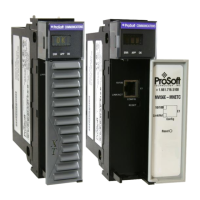
Do you have a question about the ProSoft Technology MVI56E-MNETC and is the answer not in the manual?
| Brand | ProSoft Technology |
|---|---|
| Model | MVI56E-MNETC |
| Category | Server |
| Language | English |
Safety warnings applicable to North American regions for the equipment.
Safety guidelines for using the module in ATEX/IECEx hazardous locations.
Information on product certifications and compliance standards.
Lists the minimum hardware and software components needed for the module.
Explains the function and configuration of the module's setup jumper.
Step-by-step guide for physically installing the module into a ControlLogix chassis.
Instructions for creating a new project in RSLogix 5000 for the module.
Prerequisites and download information for the module's Add-On Instruction.
Steps to add the MVI56E-MNETC/MNETCXT module within RSLogix 5000.
Guide on how to import the Add-On Instruction into the RSLogix project.
Instructions for adding more than one module of the same type to a project.
Steps to establish PC communication with the ControlLogix processor via serial interface.
Process for compiling and transferring the sample program to the processor.
Introduction to ProSoft Configuration Builder for module configuration.
Steps to download and install the ProSoft Configuration Builder software.
Procedure for converting existing MVI56-MNETC configurations.
Steps to start a new project within ProSoft Configuration Builder.
Guide to configuring the module's parameters within the software.
Details database setup and module-level parameters.
Configuration of database offset information for MNET Servers.
General configuration for the MNET Client (Master) settings.
Configuration of the Modbus TCP/IP Client command list.
Defines static IP addresses for ARP resolution to reduce network traffic.
Procedure to configure the module's Ethernet settings (IP, subnet, gateway).
Methods to connect a PC to the module for configuration.
Steps to connect using Rockwell's CIPconnect technology.
Instructions for connecting via RSWho.
How to connect directly to the module's Ethernet port.
Process for downloading configured project files to the module.
Explanation of controller tags for managing module communication.
Breakdown of the MNETC main controller tag structure.
How UDTs organize data types for controller tag structures.
Description of UDTs defined for the MVI56E-MNETC Add-On Instruction.
Detailed overview of MNETC controller tags.
Details on MNETC.DATA for input/output transfer between processor and module.
Explains MNETC.CONTROL for requesting special tasks from the module.
Details on MNETC.STATUS for module and client status data.
Explains MNETC.UTIL for data transfer variables.
Explains the status indicated by the module's Ethernet port LEDs.
Interpretation of the scrolling LED display for module status.
Interpretation of the non-scrolling LEDs for module status.
Steps to clear a fault condition indicated by the module's LEDs.
Steps to resolve issues related to module LEDs.
Guide to accessing module diagnostics via ProSoft Configuration Builder.
How to view module hardware and firmware information.
Viewing backplane status information for the module.
How to view the module's internal database contents.
Viewing configuration and status for MNETC servers.
Viewing configuration and status for MNET Clients.
Methods to access module status information.
Description of controller tags in the MNETC.STATUS structure.
Explains the bit-mapped format indicating configuration errors.
Ways to view Client Command Errors.
Accessing the module's internal web server.
Lists technical specifications for the MVI56E Modbus TCP/IP Client/Server module.
Key features and compatibility details of the module.
Details module's functional capabilities and data handling.
Lists the physical and environmental specifications of the module.
Describes how the module operates and transfers data.
How the module communicates data across the ControlLogix backplane.
Explains the structure and function of normal data transfer blocks.
Describes optional blocks for requesting module tasks.
Illustrates data flow between the module and processor.
Details recommended Ethernet cable types and configuration.
Information on Modbus protocol commands supported by the module.
Background on the Modbus protocol and its implementation.
Explains how to read coil status using Modbus Function Code 01.
Explains how to read discrete input status using Modbus Function Code 02.
How to retrieve contents of holding registers using Modbus Function Code 03.
How to retrieve controller input registers using Modbus Function Code 04.
How to force a single coil ON or OFF using Modbus Function Code 05.
How to modify holding register contents using Modbus Function Code 06.
How to read Exception Status outputs using Modbus Function Code 07.
Tests for communication systems and internal error conditions using Modbus Function Code 08.
How to force multiple coils ON or OFF using Modbus Function Code 15.
How to change contents of multiple holding registers using Modbus Function Code 16.
Explains normal and exception responses in Modbus communication.
Guide to using the optional Add-On Instruction for specific tasks.
Prerequisites for using the optional Add-On Instruction.
Describes tasks performed by the optional Add-On Instruction.
Steps to import the optional Add-On Instruction into RSLogix.
How to read the module's Ethernet configuration using the Add-On Instruction.
How to write Ethernet settings to the module using the Add-On Instruction.
How to read the module's clock value using the Add-On Instruction.
How to write the module's clock value using the Add-On Instruction.
Steps to add the module to an already created RSLogix project.
Guide to obtaining and using a sample program for the module.
Steps to open the sample program in RSLogix 5000.
How to configure the sample program for the correct ControlLogix controller.
How to specify the module's slot number in the RSLogix project.
Process for downloading the sample program to the processor.
How to integrate sample ladder logic into an existing application.
Information and requirements for contacting technical support.
Details regarding product warranty terms and conditions.